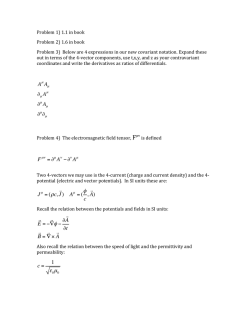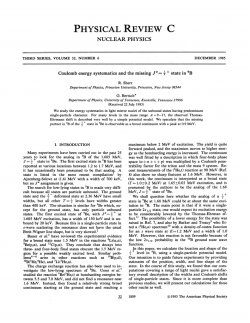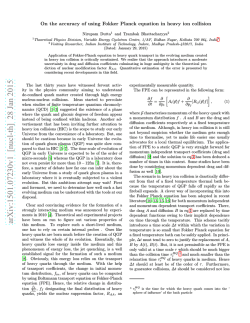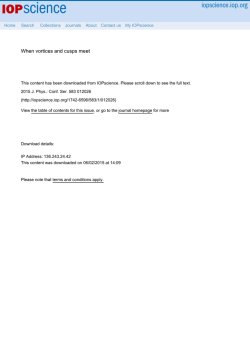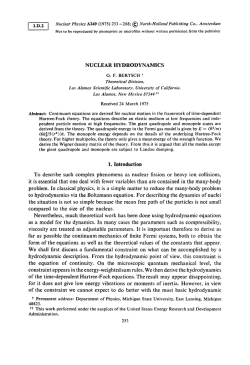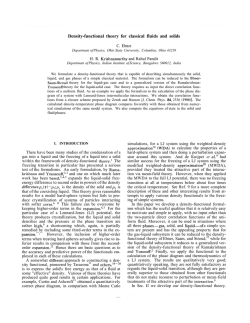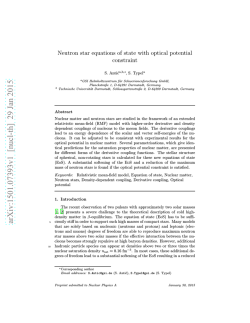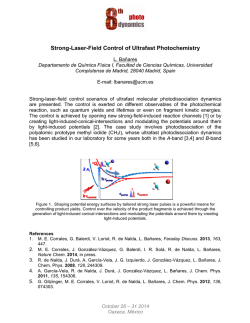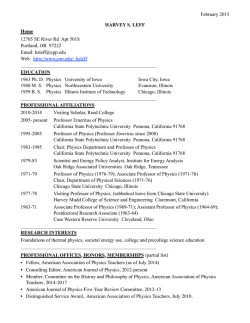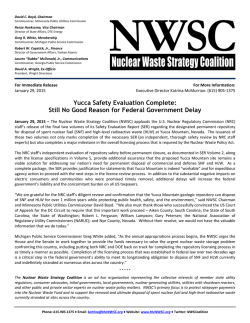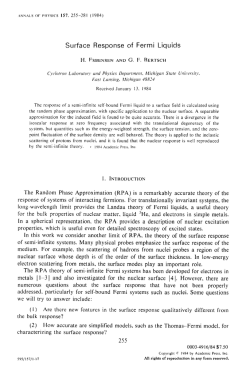
Kaons in a hot and flavor-asymmetric medium
NUCLEAR
PHYSICS A
ELSEVIER
Nuclear Physics A 651 (1999) 59-70
www.elsevier.nl/ locate/npe
Kaons in a hot and flavor-asymmetric medium
M.C. Ruivo, C.A. de Sousa, C. Providancia
Departamento de Ffsica, Universidade de Coimbra, P-3004-516 Coimbra, Portugal
Received 10 November 1998; revised 15 February 1999; accepted 17 February 1999
Abstract
We investigate the behavior of kaons in a flavor-asymmetric quark medium at finite temperature,
within SU(3) Nambu-Jona-Lasinio type models. The effect of the Fermi sea on kaon properties is
weaker in the model which includes a vector-pseudovector interaction than in the model without
it. The study of the combined effect of density and temperature on the vacuum and kaon properties
shows that the low temperature regime does not change significantly the effects observed at T = 0;
as the temperature increases the mass splitting between K + and K - modes, however reduced, is
still meaningful. (~) 1999 Elsevier Science B.V. All rights reserved.
PACS: 11.30.Rd; 14.40.Aq; 21.60.Jz
Keywords: NJL model; Chiral symmetry; Three-flavor thermodynamics; Flavor-asymmetric matter
1. Introduction
One of the important questions in intermediate and high energy physics is the understanding of strongly interacting matter as a function of temperature and density. It
has been shown in the framework of some models that, at sufficiently high temperature
a n d / o r density, spontaneously broken symmetries are restored. Restoration of symmetry
is also expected to hold for the dynamically broken chiral symmetry in QCD. It is
believed that this phenomenon could occur in heavy-ion collisions, the early universe
and neutron stars.
For zero density and finite temperature the most reliable existing information comes
from lattice calculations, indicating that both the cbiral transition and the confinementdeconfinement phase transition take place at the same temperature Tc ~ 150 M e V [ 1 ].
For finite densities no firm lattice results are available. In this situation, simplified models
may give some insight into hadronic matter at finite densities and temperatures which
is necessary for the interpretation of the experimental data that have started to appear.
0375-9474/99/$ - see front matter (~) 1999 Elsevier Science B.V. All rights reserved.
PII S0375-9474(99) 001 05-0
60
M.C. Ruivo et al./Nuclear Physics A 651 (1999) 59-70
The problem of how the properties of the hadrons change in hot nuclear matter in
comparison to their free values is nowadays an important issue in nuclear and particle
physics [2]. In particular, the study of possible modifications of pseudoscalar mesons
is extremely interesting since, due to their Goldstone boson nature, they could provide a
signal for the restoration of chiral symmetry. Since the pioneering work of Kaplan and
Nelson [3] a great amount of theoretical work on kaons in flavor-asymmetric medium
has been reported [4-11 ]. A conclusion emerging from most of the theoretical attempts
of dealing with this problem is the prediction of a slightly raising mass for the K + and
a decreasing mass for the K - , a prediction which is supported by the analysis of the
data on kaonic atoms [ 12] ; the way in which such splitting occurs is of course model
dependent.
Fundamental changes in meson properties seem necessary to explain experimental
results such as those from KaoS and FOPI collaborations at GSI [ 13-15]. The K ÷ and
K - yield are comparable at the same available energy, which is surprising since K production is suppressed in p p collisions by an order of magnitude at the same available
energy. The elementary rate of K - is lower and its absorption is stronger. Recent
data [15] on kaon production in Ni+Ni collisions show a K - / K + rate larger than in
nucleon-nucleon collisions, which indicates an enhancement of the K - production in
the medium.
It is well known that a many-body system, such as a hadronic medium, can exhibit a
great variety of particle-hole excitations that may carry quantum numbers of the hadrons
under investigation, the kaons in the present case. The interplay between the different
modes may produce changes in kaon properties.
The pursuit of theoretical approaches in order to understand the in-medium kaon
behavior remains challenging. The Nambu-Jona-Lasinio (NJL) model [16] model is
very successful in the description of many features in hadron physics. This model is also
suited to study the chiral transition of infinite uniform quark system. The two-flavor NJL
model has been used for this purpose by many authors [17-20]. The chiral transition
for the three-flavor case as well as kaon properties have been studied at zero chemical
potential [21,22] and at non-zero chemical potential [23,24,5].
Our program is to examine the properties of kaons as a function of density and
temperature taking into account the Fermi sea effects.
Recently, we have studied the behavior of kaons in a type of asymmetric quark
matter (simulating symmetric nuclear matter: p,~ = pa, ps = 0) and the new findings
concern mainly flavor-asymmetric effects on kaonic modes [7]. We have observed the
splitting between K ± and the occurrence of a low-lying K - - like branch at low baryonic
densities. This branch is not significantly affected by the inclusion of strange matter in
the medium while the flavor asymmetry is preserved [8]. We remark that, while the
K + are excitations of the Dirac sea, the low-lying branch, a non-trivial dynamical
consequence of flavor symmetry breaking of the medium, is a collective particle-hole
excitation of the Fermi sea.
It is pertinent to have a closer look into the behavior of the kaonic modes and the
present investigation is addressed to two main points: (i) the influence of the vector-
M.C. Ruivo et al./Nuclear Physics A 651 (1999) 59-70
61
pseudovector interaction on the behavior of the kaons in the presence of Fermi sea
effects; (ii) the role played by both density and thermal effects on the vacuum and kaon
properties. The present study is based on the time-dependent Hartree-Fock theory in the
formalism of the density matrix. This framework provides a unified description of the
equation of state of hadronic matter and its excitations at zero and non-zero temperature.
Along the above lines, this paper is organized as follows. In Section 2 we give a review
of the model and formalism at finite baryonic density and temperature. In Section 3 we
present and discuss our numerical results. Section 4 states our concluding remarks.
2. Modelling temperature and density effects
We adopt a three-flavor version of the NJL model which, besides the scalar-pseudoscalar and vector-pseudovector interaction terms, includes the 't Hooft six fermion interaction that models the axial U ( I ) A symmetry breaking. The model is defined by the
following Lagrangian:
1
8
L = gl(iyua~ - m ) q + ~gs Z [
(qaaq) 2 + (gliysaaq) 2 ]
a=O
8
- - l g v ~_~[ ( glruAaq) 2 + (~ru'ysAaq) 2]
a=0
+ g o {det[~s( 1 + Ys) qj] + det[~i( 1 - Ys)qj] },
(1)
where q = ( u , d , s ) are the quark fields and Aa (0 ~< a ~< 8) are the U ( 3 ) flavor
matrices. The model parameters are m = diag(mu, me, ms), the current quark mass matrix
(ma = m , ) , the coupling constants gs, gv and go and the cutoff in three-momentum
space, A, which regularizes momentum space integrals. In order to discuss the effects
of the vector-pseudovector interaction we are going to consider two models: model I
with gv = 0 and model II with gv 4. O. The set of parameters in the two models are
chosen in order to fit the values in vacuum for the pion mass, the pion decay constant,
the kaon mass and the quark condensates. For model I we have m,, = 139 MeV, f,~ =
93.0 MeV, (tiu) = (rid) = - ( 2 4 6 . 7 MeV) 3, (gs) = - ( 2 6 6 . 9 MeV) 3, m r = 495.7 MeV,
f r = 98.9 MeV, with the parameter set A = 631.4 MeV, gsA 2 = 3.658, g o A 5 = - 9 . 4 0 ,
mu = md = 5.6 MeV and ms = 135.6 MeV; for model II: mr = 140 MeV, f~- =
93.3 MeV, (t~u) = ( d d ) = - ( 2 8 7 . 0 MeV) 3, (Xs) = - (306.2 MeV) 3, m r = 498.7 MeV,
f r = 98.4 MeV, with the parameter set: A = 750 MeV, gsA 2 = 3.624, gvA 2 = 3.842,
g o A 5 = - 9 . 1 1 , mu = me = 3.61 MeV and ms = 88.0 MeV.
Let us discuss the equilibrium states at finite temperature and density. The groundstate of the system can be described by the density matrix given by f = d i a g ( f , , fd, fs)
with
1
fi = ~ [ l ( n [ - + n +)
flMi + oL. p ( n 7 _ n+ ) ] O(A2 _
Ei
p2),
(2)
M.C. Ruivo et al./Nuclear PhysicsA 651 (1999) 59-70
62
where n~q:) (i = u, d, s) are the Fermi distribution functions of the negative (positive)
energy states, which have the form
n~~) = [1 +exp(q:(•(EiqzAEi
± #i)))]-l.
(3)
In the last equation/3 = l/T, tzi is the chemical potential, Mi is the constituent quark
mass, Ei = ( p 2 + M 2) 1/2 and AEi is the energy shift induced by the vector-pseudovector
interaction.
To investigate the equation of state at finite density and temperature we consider the
thermodynamical potential 12 = £ - TS - Z i [-l'iNi, where
£=-2NcV~i
-Us Z
(27r)
3d3p P2+mM
i (ni[-n+)O(A2-p2)Ei
( ({liqi) ) 2 + gv ~
i
( (qi+qi) ) 2 - 2go(Su) (dd) (gs)
(4)
i
is the internal energy,
S = - 2 N c V _ _ Z j ~f
d3p O(A
" 2 _p2)
I
× { [ , ? ~nn? + (t - n,+)ln(l - ~?)] + [~F -* " 7 ] }
(5)
is the entropy, V is the volume of the system and Nc = 3.
The quark condensates and the quark densities are defined, for each one of the flavors
i = u, d, s, respectively as
(cTiqi) = - 2 N o
d3p Mi
(2~) 3 ~ (n;- - n?)O(A 2 - p2),
Pi = (qi+ qi) = 2Nc J ~
d3p
(n F + n + - 1)0(A 2 - p2)
(6)
(7)
The quark masses, Mi, and the energy shifts, AEi, are determined self-consistently
by minimizing the thermodynamical potential s2 with respect to the constituent quark
masses Mi and to the chemical potential tzi, respectively. This leads to six gap equations
Mi = mi -- 2gs (cliqi) -- 2gD ({ljq.j)(glkq~),
(8)
with i, j, k cyclic, and
AEi = 2gv(qi+ qi).
(9)
The excited states are described as deformed states generated from the state of equilibrium by the application of suitable generators S. This means that the density matrix
which describes these states is of the form f = exp(iS)fo e x p ( - i S ) , S being a hermitian
time-dependent operator and f0 the equilibrium matrix density.
M.C. Ruivo et al./Nuclear Physics A 651 (1999) 59-70
63
For small amplitude excitations the time evolution of the system is governed by the
Lagrangian
i
g(2)
Z; = ~ t r ( f 0 [ S , S ] ) (f),
(10)
where g ( 2 ) ( f ) is the quadratic term in the generators of the energy functional [20].
Here we choose the generator S in the form
SK = ('ysLj + i/375L2 +/3~r. pL3 + o" • pLa)AK + c.c.,
where AK is (A4 4 - i & ) / v ~ for K - ( K + ) , and L I , L e , L3 and L4, variational functions
of p, t, play the role of canonically conjugate coordinates. We remark that this operator
is more general than the one used in our previous works [7], since now we are dealing
with an anharmonic situation due to introduction of temperature. The dispersion relation
derived from the Lagrangian (10) is of the form
(1-
KpJpp)
(1 -
K A J A A ) -- K p K A J 2 p A = 0,
w h e r e K p = gs + gD(dd) and
following relations:
mJpA
=
KA =
- g v . The integrals
(11)
JPA, JAA
and
Jpp
obey the
( M , + M , ) J p p + 2(fu + gs),
(.OJaa = ( Mu + Ms)JPa + 2(u+u - s+ s)
(12)
(13)
and
2Nc
Jl'e
x
/
d3p
~ M u ( M s -- Mu)_ - o)E~, tanh/3(Eu + / 2 . )
[. Es 2 - (w + E.)2Eu
2
Mu( Ms - M , ) + wEu
/3(Eu - / 2 , )
]
Es 2 - ( m - Eu)2E.
tanh
+ s --+ u, w ~ - m = 0.
2
(14)
Here /2. = tx. - AEu and w = rnx, -- ( A E . -- bEs) or w = --m K- -- ( A E u -- A E s ) ,
according to whether one wants to describe the changes in K + or K - mass.
In the present approach one can check that the NJL model satisfies Partial Conservation of Axial Current (PCAC) relations by deriving them consistently from the Energy
Weighted Sum Rule (EWSR). For a generic mesonic state Ir > with energy mr associated with the transition operator F the strength function Fr = wrl(rlF[O)] 2 satisfies the
EWSR which reads
ml =
}--~'rmrl(rlrl0)l z = I(~oI[F, in, rl]l~0).
(15)
This equation, with the transition operator defined as F = F+ + F _ , with F± =
T5(/~4 i i A S ) / V ~ , leads to the following generalization of the PCAC relation, at finite
temperature and density:
Z
2
2
mK, afK, a
~ --(mu
q- m,) [(flu) + (gs)].
(16)
This relation provides us with a tool to determine the percentage of the total strength
located in the kaonic modes, which indicates its degree of collectivity.
64
M.C. Ruivo et al./Nuclear Physics A 651 (1999) 59-70
150.0
~" 100.0
/
f
50.0
//
/
/
///
//
//
__-- . . . . . .
~fp,/
f
j
0.0
-50.0
i
0.0
i
i
i
I
i
i
i
1.0
i
I
2.0
i
i
i
i
3.0
P/Po
Fig. 1. Pressure versus the baryonic density for model 1 (dashed curves) at several temperatures: T = 0 MeV
(thick curves), T = 50 MeV (medium-thick curves) and T = 100 MeV (thin curves) and for model I1 (solid
curve) at T = 0 MeV.
3.
Results
3.1. Comparison o f the two models at finite density and zero temperature
We start with a brief discussion on the nature of the phase transition within the two
models. By performing the calculation of the vacuum properties at a fixed chemical
potential as in Refs. [ 17-19,23] one observes that, for model I, the thermodynamical
potential s2 has more than one extremum for a certain range of values of/1. at low
temperatures, the physical solution being the one which corresponds to the minimum of
s2. Consequently, a first-order phase transition is found.
If one chooses to perform the calculation at a fixed density, as in [25,26,7,8], information on the nature of the phase transition can be achieved by plotting the pressure,
P ( p , T ) = --[aC2(p,T) -- / 2 ( p = 0, T ) ] , as a function of the density as is shown in
Fig. 1. It can be seen that for model I (dashed lines) the phase transition is first order
for T ~< Tc --~ 50 MeV. As a matter of fact for T = 0 M e V there is a range of densities (0.1p0 ~< p ~< 2,00) where the pressure a n d / o r the compressibility are negative,
meaning that the system is in a mixed phase. As the temperature increases this range of
densities becomes smaller and disappears above Tc, the pressure becoming positive and
monotonously increasing with density. The conclusions concerning the phase transition
diagram are equivalent to those discussed in [ 18] for the two-flavor NJL model.
With model II (full line of Fig. 1) the pressure and the compressibility are positive
for all temperatures and the phase transition is second-order as already shown in [24].
65
M.C. Ruivo et al./Nuclear Physics A 651 (1999) 59-70
900.0
"'--.
T=0 MeV
600.0
,,...,
• ,,,
. . . . . . . . . . . . . . . . .
,'"
;iJ...... .....................
v
500.0
K-
0.0
I
0.0
I
I
I
I
i
I
I
1.0
~
I
2.0
I
i
I
I
3.0
P/Po
Fig. 2. Kaon masses in symmetric nuclear matter as a function of baryonic density at T = 0 MeV, for model
1. The lower curve refers to the s~ low-lying mode starting at p = 0.6,00. The dotted region coincides with
the mixed phase. The two lower dashed curves represent the boundaries of the continuum of the Fermi sea.
The upper dashed curve represents the threshold Mu + M~.
The inclusion of the vector-pseudovector interaction also has important consequences
for the kaonic behavior, as can be seen by comparing the results of model I and II. For
model I (see Fig. 2), as already reported in [ 7 ] , we observe a splitting between the
masses of K ÷ and K - excitations of the Dirac sea, the increase in m r , being due to
Pauli blocking effects. The effect of the Fermi sea particle-hole excitation continuum
is strong enough to induce, above certain densities, an increase of the upper K - mass
and the occurrence of a sub-threshold K - - l i k e mode. This low-lying excitation is first
embedded in the Fermi sea continuum and, only at densities where the attraction is
strong enough ( p = 0.6p0), it decouples from the continuum. We notice that, since
the system is in a mixed phase in the range of densities between 0.1p0 and 2p0, the
solutions found for the kaon masses (dotted lines of Fig. 2) should be interpreted as
average values.
Some comments are in order concerning the low-energy branch, which has a nature
different from the upper K +, K - modes. As a matter of fact, while these modes are
excitations o f the Dirac sea, the low-energy branch is a particle-hole excitation of the
Fermi sea. Branches with a similar origin have been found in other models [4,11 ] and
were interpreted as h y p e r o n - p a r t i c l e - n u c l e o n - h o l e states. Let us discuss which meaning
should be assigned to such a low-energy branch in the present case.
It is well known that the hyperons located below the K - N threshold are of particular
importance for the K - N dynamics. In particular, the A(1405) seems to play an essential
role on the behavior of the in-medium K - . In a K - N system one can have, besides
66
M.C. Ruivo et al./Nuclear Physics A 651 (1999) 59-70
900.0
--..
T=0 MeV
600.0
~'~
-.
I~500.0
-
0.0
I
0.0
I
I
f -I
I
I
i
1.0
~
I
2.0
~
i
i
14
5.0
P/Po
Fig. 3, Kaon masses in symmetric nuclear matter as a function of baryonic density at T = 0 MeV, for model
I1, The dashed curves have a similar meaning to those of Fig. 2, but with a shifting of -2gyp,.
the A ( 1 4 0 5 ) resonance a A ( 1 4 0 5 ) - p a r t i c l e - p r o t o n - h o l e state, which is the analogue of
M i g d a l ' s ~ + mode in a ~ ' - N system. In NJL type models one does not have bound
nucleons and hyperons and an extrapolation from a quark system to a baryon system
should be made. Keeping in mind these limitations of the model one can interpret
the subthreshold mode (an s-particle-u-hole excitation) as simulating the effects of a
A-particle-proton-hole state. Parity analysis leads us to consider this excitation as the
analogue of the A( 1116)-particle-proton-hole state. The excitation energy of the mode
(~- 200 M e V at p ~_ 0.6p0) also makes this interpretation plausible.
As pointed out in our previous works [7,8], the energy weighted sum rule gives us
important information on the character of these two branches: the lower branch, initially
weak collective, acquires strength as the density increases and, at a certain density,
overtakes the K - branch which looses strength, becoming, therefore, less bound.
The results for model II (see Fig. 3) show that the vector-pseudovector interaction
term partially cancels some Fermi sea effects: (i) it reduces the repulsion above the
Fermi sea continuum, the net effect being a moderate decrease of the mass of the K Dirac sea excitation; (ii) it reduces the attraction below the Fermi sea continuum, inhibiting therefore the occurrence of the low-lying s-particle-u-hole mode. This behavior
follows qualitatively the same tendency as in [9], where kaon properties in the medium
were studied within a chiral effective model and taking into account Pauli blocking, N N
correlations and Fermi motion. As in that calculation, the dominant effect we found is
Pauli blocking, although, in our case the decrease of the K - mass is less pronounced.
As a matter of fact, we do not have a bound s-particle-u-hole state anymore, but we
M.C. Ruivo et al./Nuclear Physics A 651 (1999) 59-70
67
still have a narrow continuum of s-particle-u-hole excitations which acts repulsively
in the K - mode, as explained above. The K + is only slightly affected by the vector
interaction.
It is illustrative to look also at the limits of the Fermi sea continuum in both models
(see Figs. 2 and 3). In model II the continuum is shifted below and narrowed. The
shifting is mainly due to a change of M,, = 335 MeV, in model I, to Mu = 369 MeV,
in model II, which was dictated by the requirement of fitting the parameters to the
experimental data. On the other hand, the boundaries of this continuum are now M~ M u - 2 g v p u , IZs - tz~ - 2 g v p u .
To the best of our knowledge there is no definitive answer on the way the phase
transition occurs in nature [27], especially when asymmetric quark matter is considered,
so there is no reason to prefer one of the two models considered here on the basis of
experience or phenomenology concerning the phase transition. However, the model II
has the advantage of allowing the description of the system in the hadronic phase (in
model I this does not happen in the energy range (0.1p0,2p0)).
3.2. C o m b i n e d effects o f d e n s i t y a n d t e m p e r a t u r e
From now on we are going to discuss the combined effect of temperature and density
on kaonic modes. The interesting thing to be noticed in model I is that the s-particle-uhole collective excitation is only present at zero and very low temperatures. Afterwards
the behavior of the kaon modes is qualitatively similar to the observed in model II. In
the following we concentrate in the discussions on the results for model II.
At low temperatures the masses of the kaon modes exhibit a behavior identical to
the one observed at T = 0 MeV (see Fig. 4). For higher temperatures the behaviour of
the kaon masses is still qualitatively similar to the one observed at lower temperatures.
However, we can notice that the splitting between K + and K - decreases with temperature
at a given density. The behavior of K + with temperature and density is determined
by two competing processes. On the one hand, the temperature increases the number
of available states to the collective excitations; on the other, the non-strange quark
condensate starts increasing with T at a given density. While the first mechanism is
dominant for the behavior of K +, the behavior of K - is a balance between both.
We notice that the dominant effect is the reduction of the splitting between K +, K masses, which, however, remains still meaningful. For instance, at T = 100 MeV the
attractive effect on K + is more pronounced but we also observe that, above p ~_
2p0, the K - mass starts to decrease more strongly. At T = 100 MeV p _~ 2.5p0 an
appreciable splitting, around 200 M e V , is found. This means that under the combined
effect of temperature and density, the K - are still easier to produce in medium, which is
compatible with experimental data that indicate an enhancement in K - production [ 15 ].
Concerning the information from the EWSR, we have checked that in model II
the strength exhausted by the collective bound states shows an identically satisfactory
behavior, although at high densities the percentage of the total EWSR exhausted by the
collective modes is lower, as can be seen from Fig. 5 for T = 100 MeV. This is probably
M.C. Ruivo et al./Nuclear Physics A 651 (1999) 59-70
68
770.0
700.0
K + / , .
~" 630.0
""
ff
°.*
560.0
"""
."
t"
I"
." .~'"
. ..:~..',¢.:~"~"
490.0
'''''
420.0
~ I'
0.0
'-''''
I ~'''''
0,7
]-',"'"'ff;~'7
1.4
2.1
2.8
P/Po
Fig. 4. Kaon masses in symmetric nuclear matter as a function of baryonic density at T = 0 M e V (solid
curves), T = 20 M e V (dashed curves), T = 50 M e V (dotted curves) and T = 100 M e V (dashed-dotted
curves) for model I1.
1.0
0.8
T=IO0
MeV
i~0.6
bt
K-
~
~
~
i
I
i
K +
0.4
0.2
I
0.0
I
i
0.5
I
I
I
I
I
t
i
i
1.0
I
1.5
i
I
I
i
[
2.0
p
i
i
2.5
P/Po
Fig. 5. Percentages of the energy weighted sum rule exhausted by the K :k bound states as a function of
baryonic density at T = 100 M e V for model II. The sum of these percentages is represented by the full line.
M.C. Ruivo et al./Nuclear Physics A 651 (1999) 59-70
69
due to the fact that the continuum modes, which are not taken into account in the sum
rule, acquire more strength.
4. Conclusions
Let us summarize our main results. We have studied properties of the vacuum and of
kaons in a flavor-asymmetric medium and at finite temperature, paying special attention
to the effects of the Fermi sea, within two SU(3) NJL type models, one without (I)
and the other with (II) vector mesons. At zero temperature a first-order phase transition
occurs in model I, while in model I! a second-order one takes place; the increase of
the temperature has the effect of turning out the phase transition to second order in
model I. Concerning the behavior of kaons, we conclude that the vector-pseudovector
interaction reduces the effects of the Fermi sea. As a consequence, K - is a smoothly
decreasing function of density and the low energy s-particle-u-hole excitation of the
Fermi sea, present in model I, does not exist as a collective state in model II. A
very low temperature regime does not affect noticeably the behavior of kaons. As the
temperature increases a moderate reduction of the splitting between the kaon modes is
the dominant effect.
Acknowledgements
We would like to thank J. da ProvidEncia for fruitful discussions. We thank the referee
for useful comments. This work has been supported in part by projects PRAXIS/PCEX/
C/13/96, CERN/S/FIS/1034/95, ESO PESO/S/PRO/1057/95, PRAXIS/2/2.1/FIS/
451/94 and PRAXIS/P/FIS/12247/98.
References
[ 11
121
[31
[41
t51
161
171
[81
191
F. Karsch, Quark-gluon plasma, ed. R.C. Hwa (World Scientific, Singapore, 1990).
W. Cassing and E.L. Bratkovskaya, Phys. Rep. 308 (1999) 65.
D.B. Kaplan and A.E. Nelson, Phys. Lett. B 175 (1986) 57; B 192 (1987) 193.
H. Yabu, S. Nakamura, E Myhrer and K. Kubodera, Phys. Lett. B 315 (1993) 17.
M. Lutz, A. Steiner and W. Weise, Nucl. Phys. A 574 (1994) 755.
J. Schaffner, A. Gal, I.N. Mishustin, H. St6cker and W. Greiner, Phys. Lett. B 334 (1994) 268.
M.C. Ruivo, C.A. de Sousa, Phys. Lett. B 385 (1996) 39.
C.A. de Sousa and M.C. Ruivo, Nucl. Phys. A 625 (1997) 713.
T. Wa~s, N. Kaiser and W, Weise, Phys. Lett. B 379 (1996) 34; T. Waas, M. Rho and W. Weise, Nucl.
Phys. A 617 (1997) 449.
[101 G.Q. LI, C.-H. Lee and G.E. Brown, Nucl. Phys. A 625 (1997) 372.
I l l ] M. Lutz, Phys. Lett. B 426 (1998) 12.
11211 E. Friedmann, A. Gal and C.J. Batty, Nucl. Phys. A 579 (1994) 518.
[ 131 A.H. Schr6ter et al., Z. Phys. A 350 (1994) 101.
[ 141 H. Herrman, FOPI Collaboration, Nucl. Phys. A 610 (1996) 49c.
[151 R. Barth et al., KaoS Collaboration, Phys. Rev. Lett. 78 (1997) 4007.
[ 161 Y. Nambu and G. Jona-Lasinio, Phys. Rev. 122 ( 1961 ) 345; 124 ( 1961 ) 246.
70
M.C. Ruivo et aL/Nuclear Physics A 651 (1999) 59-70
[ 17[ M. Jaminon, G. Ripka and E Stassart, Nucl. Phys. A 504 (1989) 733.
[18] M. Asakawa and K. Yazaki, Nucl. Phys. A 504 (1989) 668.
119] S.E Klevansky, Rev. Mod. Phys. 64 (1992) 649;
P. Zuang, J. Hiifner and S.E Klevansky, Nucl. Phys. A 576 (1994) 525.
[20] J. da Provid~ncia, M.C. Ruivo and C.A. de Sousa, Phys. Rev. D 36 (1987) 1882;
C.A. de Sousa, Z. Phys. C 43 (1989) 503;
M.C. Ruivo, C.A. de Sousa, B. Hiller and A.H. Blin, Nucl. Phys. A 575 (1994) 460.
121 ] 1". Hatsuda and T. Kunihiro, Phys. Rep. 247 (1994) 221.
[22] M. Jaminon and B. Van den Bossche, Nucl. Phys. A 582 (1995) 517.
[23] J. Cugnon, M. Jaminon and B. Van den Bossche, Nucl. Phys, A 598 (1996) 515.
[24] S. Klimt, M. Lutz and W. Weise, Phys. Lett. B 249 (1990) 386.
[251 V. Bernard and U.G. Meissner, Nucl. Phys. A 489 (1988) 647.
126] T. Maruyama, K. Tsushima and A. Faessler, Nucl. Phys. A 537 (1992) 303.
[27] H. Mfiller, Nucl. Phys. A 618 (1997) 349.
© Copyright 2025
